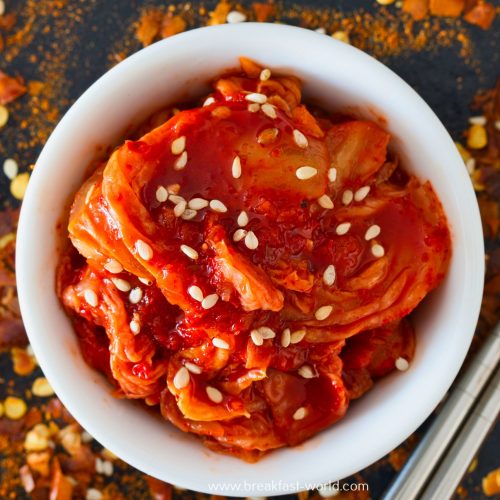
Kimchi
Ingredients
- 1 Napa cabbage
- 10 tbsp. Salt without additives
For the paste
- 6 garlic cloves
- 4 cm ginger
- 1 Asian Pear
- 1 tbsp. Glutinous rice flour
- 200 ml water
- 3 green onions
- 2 tbsp. Korean chili powder
- 1 tbsp. Korean chili flakes
- 2 tbsp. Fish sauce
Instructions
- Cut Napa cabbage in half lengthwise and then into bite-sized pieces.
- Generously sprinkle vegetables with salt and let sit for at least 2 hours.
- Then rinse the vegetables thoroughly and drain well.
- Peel the garlic cloves, ginger and nashi pear and cut into coarse pieces.
- Cut the spring onions into thin strips approx. 3 cm long.
- Mix glutinous rice flour with water and bring to the boil, stirring constantly, until the liquid becomes glassy. Then continue to simmer for a moment over low heat. Let cool down.
- Mix the ginger, garlic, nashi pear with the cooled rice porridge and then puree it finely with a hand blender. Mix in the chili powder and fish sauce.
- Mix the Chinese cabbage and spring onions well with the seasoning paste. If necessary, season with a little fish sauce.
- Pour vegetables into the prepared jars. Make sure to press the vegetables in as firmly as possible so that air escapes and prevents mold from forming. Leave approx. 2 cm of space at the top edge.
- Place the marinated vegetables in a glass or plastic container and press gently to remove air bubbles.
- Seal the container and let it ferment at room temperature for about 2-4 days.
- Then store the kimchi in the refrigerator until ready to eat.
- The kimchi can be consumed after about 7 days. It gets even tastier over time.
Notes
Depending on how strong the fermentation process is at the beginning and how full the jar is, the lid may bulge after a few days. This is normal. However, to prevent the contents from overflowing or, in the worst case scenario, the jar from bursting, it is advisable to carefully open the jar to release the pressure and then close it again. Additionally, the jar should be placed on a plate during fermentation to be on the safe side.
Fresh kimchi tastes even better when sprinkled with some toasted sesame seeds before eating.
Kimchi tastes great both on its own as a salad and as a side dish, especially with fried tofu and rice.